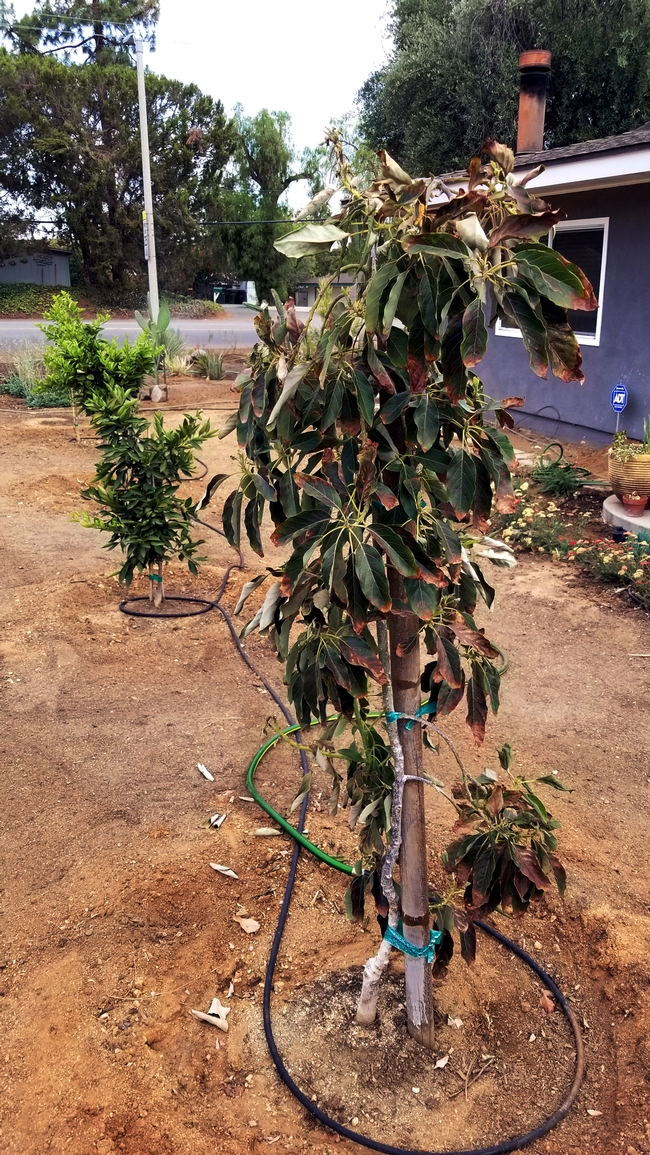I just returned from a 10-day camping vacation. It seems whenever I am away the temperature reaches triple digits. This year proved no different, except wondering how our recently planted citrus and avocado grove on the very exposed south side of the house endured. When we planted the young trees this spring, all sorts of folks felt the need to pull their cars up to the curb and tell us what a bad idea it was to plant trees where they would get sun and wind exposure. We smiled and said, “thank you!” not fully understanding the impact of our tree placement.
When we returned from our trip and drove up to the house, we were happy to see the citrus trees were doing just fine, but those avocado trees were totally stressed out!
So, I am asking myself, did I really do the research I needed to do before planting this young grove between the street and my house? Have I done all I can to help my newly planted trees get through the hot summer? Here are a few things I have learned this week:
1. One of the best ways to avoid heat damaged trees is to select species adapted to one's climate. Were avocado trees a solid choice for my Sunset Zone? Here is how to identify your climate zone: https://www.sunset.com/garden/climate-zones/sunset-climate-zone-los-angeles-area
Newly planted trees are the most heat-susceptible plants. The roots have not had a chance to become established. Turns out citrus and avocado thrive in my climate zone; however, it would be helpful to shade them from the sun and wind while they are young.
2. Before we left, I established a regular watering program with drip hoses and a timer as I have not yet installed my permanent irrigation. It is best to water early in the morning. Keep the tree trunk dry and water outward toward the drip line of the tree.
There is a condition called ''physiological stress' which results from a plant losing water (from transpiration) faster than water can be taken up by the roots, even if enough water is available. This occurs often late in the afternoon of a hot day. Further watering will not help and can lead to root rot unless the roots are truly dry! Check the roots several inches deep to find out how dry the soil actually is.
3. Mulch would have been very helpful, and I neglected to apply the desired 3-4 inches. Keep mulch several inches away from the trunk and remember to replenish it as it breaks down. The mulch keeps soil moisture in and weeds out and buffers soil temperature reducing heat stress.
4. Once trees are stressed from drought or heat, they often succumb to other stressors, such as insects and fungal diseases. Keeping trees healthy is essential. I will need to keep a closer eye on these trees while they recover.
While avocado and citrus are traditionally grown in where I live, there may have been better choices. On the UC ANR Green Blog, ‘UC study seeks street trees that can cope with climate change' is a very interesting piece y authored by Jeannette E. Warnert, reporting on an ongoing research study by UC Cooperative Extension scientists partnering with the U.S. Forest Service. The article also provides a sampling of trees that are part of the study. The following two sites are useful for tree selection for your climate zone: http://calscape.org/(natives) and https://selectree.calpoly.edu/(natives and compatible non-natives).